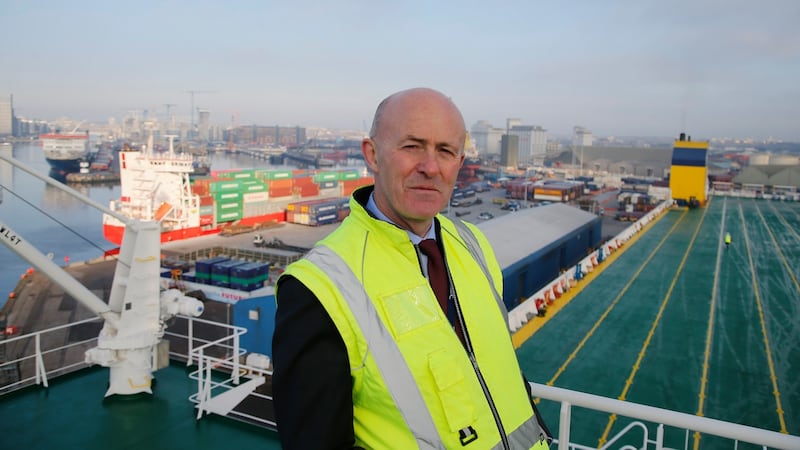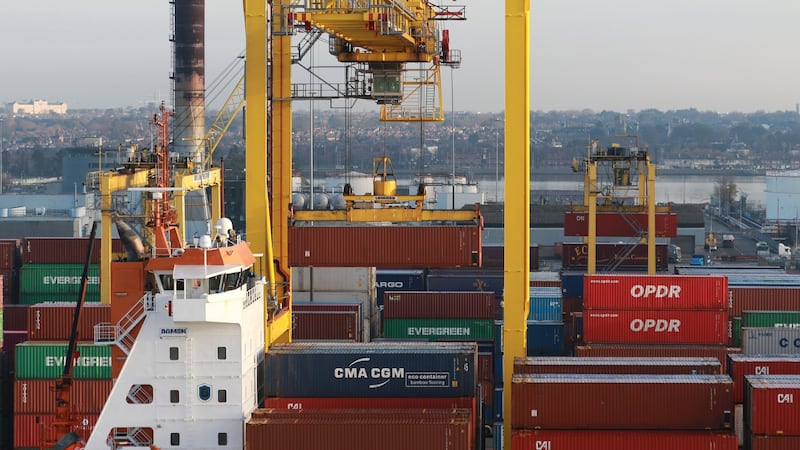The second largest freight ferry to operate on a direct route between Ireland and mainland Europe began its service out of Dublin Port on Friday offering companies additional capacity to cope with Brexit.
The MV Laureline, the smaller sister ship of the “Brexit Buster” MV Celine launched last year, offers 5.4 kilometres of lane space for lorries and other commercial vehicles on a direct sailing to continental Europe that avoids the UK “landbridge”.
The roll-on, roll-off vessel, owned by Luxembourg-based shipping line CLdN, increases the company’s capacity on direct sailings between Dublin Port and mainland Europe by 20 per cent, offering seven directly sailings a week.

The company accounts for 40 per cent of all units moved between Dublin and continental Europe. The MV Celine is the largest vessel to service this route, offering capacity of eight kilometres of lane space for trucks.
The increased capacity on direct sailings to mainland Europe will be essential if the UK’s departure from the EU leads to traffic congestion and delays resulting from new border customs checks at British ports.

Dublin Port Company chief executive Eamonn O’Reilly said the port had sufficient handling capacity to handle additional ships on more direct services to mainland Europe if they were required.
“A lot of the focus on the preparation for Brexit are about border controls, regulations, inspections but in the bigger picture the important thing is capacity to continental Europe,” said Mr O’Reilly, standing on the deck of the MV Laureline as he showed off the vessel to reporters after making its “maiden call” to Dublin.

“There is no doubt that there is going to be more trade going to continental Europe, a greater proportion than will go to the UK, precisely because of Brexit. You can have all the checks in the world but those checks are on the declining volume with Britain. We need the capacity to continental Europe.”
The new vessel, built in South Korea, is the third new ship in the CLdN feels to enter service at Dublin Port following the MV Mazarine in 2010 and the MV Celine, both of which were christened in Dublin.
The Laureline left Dublin Port at 3.30pm for the Belgian port of Zeebrugge on what was the original “Brexit Day” of March 29th, the date the UK was supposed to have left the EU. Brexit has been delayed until April or May, or possibly later if the House of Commons is unable to ratify a divorce deal with the EU.
A spokesman for CLdN said the company can develop its seven weekly calls to Zeebrugge and Rotterdam further as a direct alternative to the landbridge.
“Customers want certainty on consignments that can travel on direct rotues, even if that means a slower journey time,” he said.
Mr O’Reilly said he was confident the port would be ready for whatever Brexit comes after spending €30 million on customs and inspection posts. He stressed, however, that the port was “just one small cog in a great big supply chain.”
He believes Brexit will “destroy” long-established supply chains through the UK that work around the highly regulated limits on lorry driver hours with delays of an hour or two at ports.
“I think the State side is very well prepared. I just don’t think it is possible for all the operators in the supply chain to be adequately prepared so there will be a difficult transition,” he said.

While the port and State agencies have contingencies in place to deal with any traffic congestion into the port arising from additional customs and inspections post-Brexit, it was not clear what impact they have, said Mr O’Reilly.
“We are definitely looking at delays. There is no question of that. It’s the extent to which those delays roll over into actual congestion. We can’t foretell that at the moment,” he said.
Mr O’Reilly defended the port’s decision to reduce the number of cruise ships it will accept until 2021 so it can focus on the construction of a new jetty and quay walls to handle increased freight.
“Not taking more cruise ships and guaranteeing berths to such an extent that it makes construction impossible, that is the challenge,” he said.
The redevelopment of the Alexandra Basin on the northside of the port has allowed it to accommodate the next generation of super ferries such as MV Celine and MV Laureline.
Remaining work to redevelop two kilometres of existing berths in the basin and deepen the approach channel to Dublin Port is due for completion in 2023.









